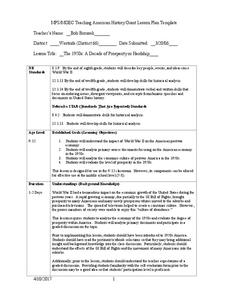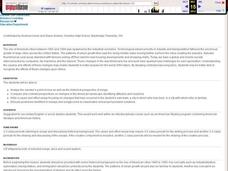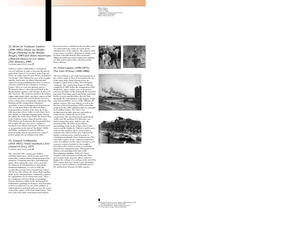Curated OER
Building Suburbia: Highways and Housing in Postwar America
Students determine how suburbs changed America. In this post World War II lesson, students complete research projects that require them to examine the growth of suburbs in the 1950's and 1960's. Students reveal how government policies,...
Curated OER
Design Your Own Suburb
Students view and discuss urban and suburban scenes; and list the features of their ideal town and discuss whether these features can be found in cities and suburbs. They draw mental maps of a city and a suburb and brainstorm and list...
Curated OER
Calgary Response to Growth
Students read about some of the ways that the city of Calgary has responded to urban growth. They determine that seemingly simple decisions about how to curtail growth are, in fact, quite challenging. They critique and propose some...
Curated OER
The Growth Of A City
Students define what a city is. They investigate the top 10 - 15 most populated cities. SDescribe factors influencing the location and growth of urban sites. They site examples of cities that have grown with different models of urban...
Curated OER
The Automobile’s Influence on Post-WWII Suburbia
Eighth graders explore post World War II America. In this American History lesson, 8th graders analyze primary and secondary sources to research how the automobile influenced the growth of suburbs, and how the growth of suburbs...
College Board
2001 AP® Human Geography Free-Response Questions
The green revolution has changed agricultural practices, but its success may be limited. Learners consider why as they use authentic College Board materials. Other prompts explore the rise of suburbs and the stages of economic development.
Curated OER
Houghton Mifflin Social Studies/Chapter 11, Lesson 3: New Ways of Living (pp. 260-263)
Fourth graders write one fact that pertains to the growth in California suburbs after World War II and another fact that pertains to the changes in the cities. Invite students to share their facts. The class can guess whether the fact...
Curated OER
Consumer Culture in the 1950s: New Shopping Centers and Advertising trends
Students examine the effect of suburbs on American cities. They identify the changes the cities had to face after people moved elsewhere. Using primary source ads, they compare them with contemporary ads and discuss what can be found out...
Curated OER
Mapping Your Neighborhood
Young scholars define and outline their neighborhoods using GIS (geographic information systems) or a regional map and relate their neighborhoods to the principles of Smart Growth.
Curated OER
The Landscape Through Geographer's Eyes
Learners examine different types of landscapes through a geographer's eye. Using a city block or a suburb, they organize their thoughts and take notes to survey a site. They discuss what they have seen and write about how looking at...
Curated OER
Chapter 22 – The 1950s
In this 1950's America worksheet, students read assigned textbook pages about the decade and respond to 47 short answer questions.
Curated OER
Inventions and Inventors
Fifth graders investigate an introduction to both Invention Convention and Unit 3 in the Social Studies Book, the teacher will point out that many changes occurred in the United States during the late 1800s and early 1900s.¿¿¿...
Curated OER
Chapter 16 – The 1920s
In this 1920's America learning exercise, students read assigned textbook pages about the decade and respond to 47 short answer questions.
Curated OER
Land Use and Lawmaking in California
Students design a plan for a housing development in their city. In this house development lesson plan, students observe pictures of land use, research lawmaking, and develop a plan for an environmentally friendly housing development in...
Curated OER
American Economics after WWII
Students analyze the American culture after WWII. Through a variety of activities, students gain an understanding of ecomonics and prosperity in the US following WWII.
Curated OER
Civil Rights/Segregation
Sixth graders investigate Civil Rights by participating in role-playing activities. In this U.S. History lesson, 6th graders research the history of slavery in order to portray a story through their debating and acting...
Curated OER
You Don’t Know What You’ve Got Until It’s Gone: The Changing American Landscape
Young scholars examine the changing American landscape. In this cause and effect lesson, students listen to rock music that exemplifies urban growth in America and the interconnectedness of America today. Young scholars write cause and...
Curated OER
Paris, a XIXth- Century City
Students plan a visit to Musse d'Orsay to examine Paris in the 19th century. In this visual arts lesson plan, students explore the Haussmanian period and urban life in the 19th century. Students discuss the relationship...
Curated OER
Urbanization
Students examine the impact of urban change. In this Indiana history lesson plan, students read excerpts of The World Does Move by Booth Tarkington and then research the noted Web sites about the urbanization of Indianapolis. Students...
Curated OER
Cooking Kansas City
Students investigate the history of Kansas City and then create recipes from the area, including Kansas City Barbecue Sauce, and Kansas City Corn.
C3 Teachers
C3 Teachers: Inquiries: Suburbs
A comprehensive learning module on the suburbanization of America after World War II that includes three supporting questions accompanied by formative tasks and source materials, followed by a summative performance task. Students examine...
PBS
Pbs Learning Media: Primary Source Set: Postwar Rise of the Suburbs
This collection uses primary sources to explore the postwar growth of the American suburbs.
Rock and Roll Hall of Fame
Rock & Roll Hall of Fame: Sti Lesson 15: The Changing American Landscape
The rise of American cities between 1865 and 1900 was spawned by the industrial revolution. Technological advancements in industry and transportation fathered the enormous growth of large cities across the United States. This led to the...
Khan Academy
Khan Academy: The Growth of Suburbia
The GI Bill made it possible for World War II veterans to finance the purchase of a house. This, combined with mass production of houses, led to the growth of suburban communities, including three Levittown suburbs.
























